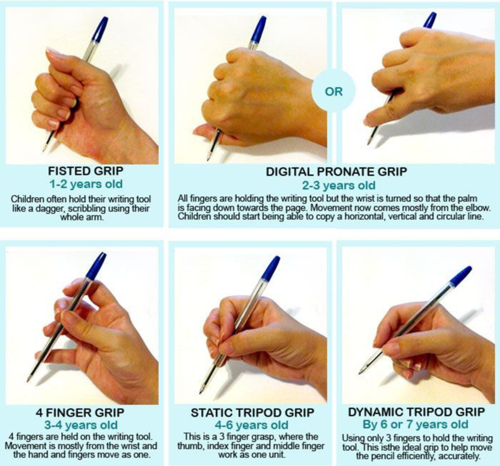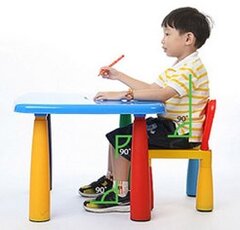Pre-writing and Handwriting Skills
This page looks at pre-writing skills which are the first step in a child learning to write. It also includes videos which talk you through the steps of how a child learns develops their handwriting skills
Pre-writing Skills
The skills involved in learning to write are called pre-writing skills. These include the sensorimotor skills that contribute to a child holding and using a pencil, and the ability to draw, copy, and colour. Sensorimotor skills are how the body receives sensory messages (vision, hearing, smell, taste, touch,) and then gives a movement response (motor output).
Below are some examples of pre-writing activities which help develop a child’s sensorimotor skills:
- Fine motor sensory activities
- Sand/rice boxes with small hidden items in it
- Pinching and rolling play dough
- Grasp and manipulation activities
- Threading/beading activity
- Dressing – buttons/zips
- Eye hand coordination activities
- Drawing
- Colouring
- Tracing
- Mazes
- Dot to Dot
- Building and construction activities
- Lego
- Arts and crafts
This video gives some examples of ways to practice fine motor skills at home, using household items.
Pencil Grasp Development
Pencil grasp development typically follows what is demonstrated in the images below. While this grasp development can be predictable, it can also vary in timing for children.

Image: NHS
Common difficulties a child can have with grasp development
- Reduced muscle tone
- Poor core strength and shoulder stability
- Difficulty holding an upright posture when seated for tabletop activities
- Eye hand coordination difficulties
- Difficulty attending to the writing activity.
Seating
A good, seated position is crucial for effective hand use, particularly for activities such as writing and cutting that call for a high degree of dexterity and focus. Dexterity is the ability to perform a difficult action quickly and skilfully with your hands.
Poor sitting posture makes it harder for children to perform these kinds of tasks. They will be less able to focus on the assigned work if they have to focus on maintaining a stable or comfortable sitting position. They may also present as restless and easily distracted. Correcting a child’s seated position can significantly impact their academic achievement and classroom confidence.

Image: NHS
For appropriate seating, please ensure:
- Hips, Knees & Ankles are at a 90* angle.
- Thighs should be fully supported on the seat, just ensure that the seat is not digging into the back of the knees.
- Appropriate seat height so that the feet are flat on the floor.
- The child’s forearms should rest comfortably on the table, without the shoulders being ‘hunched’.
Shoulder stability, core strength and fine motor skills
Almost all movements involving the upper body include the shoulders. Because shoulder stability directly affects fine motor skills, children who have weak upper body strength and stability in their core are more likely to struggle with fine motor activities.
Fine motor skills are coordinated and controlled movements the small muscles of the hand and fingers make when picking up a small object, for example, when threading a bead or placing a coin into the slot of a piggy bank box.
Activities aimed at developing shoulder and core stability and increase upper body strength
Push-ups
Do push ups while seated and on your knees. As an alternative, consider pushing up against a wall to make this simpler.
Chair push-ups
Put your hands on the sides of the chair close to your hips while you are seated. Try to get up from the chair while keeping your hands in place. Hold that position for five seconds.
Put your feet under the chair so they are not on the floor helping you.
Peanut ball
Supporting your child, get them to lie over the peanut ball. As your child pushes off the surface using their arms as well as their core to maintain balance, they are encouraging shoulder stability and strength.
This activity could be graded by placing objects (e.g. Lego) and a box on the ground. Get your child to balance themselves over the peanut ball using one hand/arm, while pick up the objects and putting them into the box with the other hand/arm.
Hand Strengthening Activities
- Wring out sponges and clothes in a bowl of water
- This is a great messy play activity that can be enjoyable.
- Hair bobbles and a water bottle - Place the hair bobble over your child’s fingers, get them to expand their fingers to place the bobble over the water bottle.
- Expanding their hand will provide a resistance on the muscles of their fingers and forearm.
- Encourage him/her to use his other hand to help guide the bobble on to the bottle.
- See how many bobbles he/she can put on to the water bottle.
- Playdough activities
- Placing playdough into a zip locked bag ensuring excess air is out of the bag.
- Squeezing the playdough will help develop his fine motor dexterity and provide your child with the sensory sound input he/she craves.
Videos
This six-part series on Handwriting Skills was delivered by the North Wicklow CDNT.
Further information